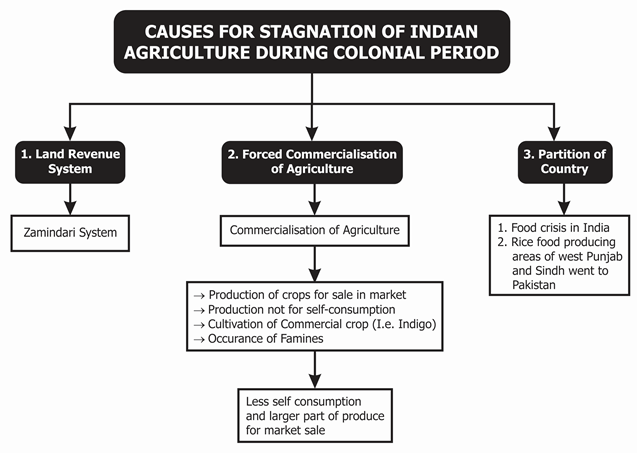Indian economy is agriculture based, or we can say that India is an agrarian economy. This is evident from the fact that the national income of India consists of 70% of the income generated from agriculture.
Before independence, the economy was 95% dependent on agriculture and the revenues earned from agriculture.
It is worthwhile to mention that around 85% of the population was living in villages, and the only means of subsistence was agriculture.
Concerning agriculture, the situation of the Indian economy on the eve of independence was disheartening.
Agriculture, even after being the most important sector, was facing economic deterioration and stagnation in the economy.
The following were witnessed with the changes in agriculture:
- High vulnerability
- Low productivity
High vulnerability means a reaction to any situation concerning the change in agricultural factors.
If the country witnesses low rainfall in a month, then the resulting impact will be low levels of output and high rates of crop failure.
Low productivity levels were witnessed, and the levels of output declined irrespective of a large area for cultivation.
Also read: Indian Industries during British rule
Here are some factors that led to the stagnation of the agriculture sector.
- The Indian economy was facing the adverse effects of the zamindari system, which is the practice of making farmers work and collect rent as tax, irrespective of the situation.
- The scarcity of agricultural resources led to the stagnancy in agriculture.
- The commercialisation of agriculture meant moving from growing goods for their consumption to growing for the market. The existence of middlemen prevented the development of the economic condition of the farmers, which caused stagnation in the agriculture sector.
Agricultural Sector during the Independence

| Also Explore: |
Causes of Stagnation of Indian Agriculture During the Colonial Period

| Q.1 Explain the state of agriculture in India on the eve of independence.
Or What were the characteristics of Indian agriculture on the eve of independence? |
|
| Answer: | |
| (A) Explanation | ● The Indian economy was an agro-based economy on the eve of independence.
● 75% of the Indian population was earning a livelihood from agriculture. ● Despite being a primary source of income for a major population, this sector faced a decline under the British rule. |
| (B) State of agriculture on the eve of independence can be observed by the following characteristics: | |
| (1) Small and fragmented land holdings | ● A landholding is defined as the area of land that a person or a family owns.
● Land holdings in India were not only small but scattered as well. ● Small and scattered land holdings were very difficult to cultivate. |
| (2) Use of outdated and old technology | ● At the time of independence, old and outdated methods of farming were used in the agriculture sector.
● There was insufficient use of fertilisers and other machines. |
| (3) Dependence on rainfall | ● Agriculture was excessively dependent upon rainfall.
● Good rainfall implied good output, while poor rainfall implied poor output. |
| (4) Low level of productivity and production | ● Level of productivity, i.e., output per hectare of land was extremely low.
● Low productivity implied a low level of output. Low output could be produced due to fragmentation despite large areas being under cultivation. |
| (5) Subsistence farming | ● Subsistence farming is one where the primary objective of a farmer is to produce for his own family.
● The sole aim is to produce for self-consumption or for his family rather than selling to others to earn money.[4] |
| (6) A wedge between owners of the soil and tillers of the soil | ● Owners were seldom the tillers of the soil, and they never shared the cost of output. Instead, they shared the output.
● They were only interested in maximising their rental income. ● The tillers of the soil (farmers) were given very less for subsistence. ● The consequence was backwardness and stagnation of agriculture. |
Stay tuned for questions papers, sample papers, syllabus, and relevant notifications on our website.

Comments